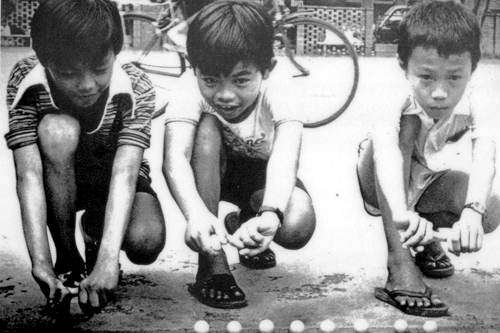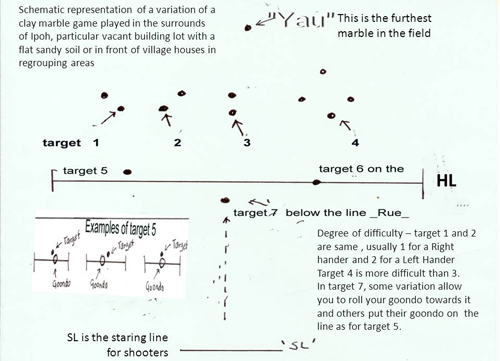As we do not have any photos of Ipoh youngsters playing marbles to illustrate the following text from ipohbornkid, I have used this one courtesy of wwwyeohongeng.blogspot.com. Perhaps some of our readers can help us out with similar photos from Ipoh or Perak. And how about some stories about other childhood games please.
Definitions
Marbles – made of clay and fired in an oven with average diameter of 2-2.5 cm. Average cost 12 marbles/10 cents
Glass marbles – made of glass and with cat eye inside win average diameter 1.2 cm-1.5cm. Cost 20 marbles/10 cents.
Goondo – Your top shooting marble usually twice the diameter of your ordinary marbles.
HL- A longer horizontal line drawn in the sand with a stick. Usually, HL is drawn parallel to a wall in front of it so the marbles cannot travel too far.
SL – The starting line where all players shoot with their goondos. The SL is about 1 metre away from the HL and parallel to it.
TM – Targetmarble. This marble is nominated by other players (in a consensual way) for the shooter. It is the targeted marble and you need to hit it to win.
Shooter – A player who is allocated the chance to shoot his goondo towards target marble.
In this article, the game involving horizontal lines game with HL & SL, is described.
HL game – The HL line, about a metre long, is drawn on the sand and is closed by two vertical lines at the ends. Another shorter line is drawn about a metre down from the HL and is the starting line where the shooter’s foot should not cross.
The game starts when each player puts in one marble into the pool and each player has a “goondo” (slightly larger than the pool marble) but it is his top shooting marble.
This is followed by a group determination of the order of player’s turn to shoot. The first shooter then takes all the pooled marbles and placed in the palm of one hand, kneels with one foot and places his front foot behind the SL. He then throws the marbles with the aim to get a good spread of marbles above the HL. Marbles straying out of the boundary defined by HL vertical lines is re-launched singularly.Some marbles may fall behind the HL. When the launch is complete, the other players get together and make a decision about the target marble and the shooter has to strike that nominatedtarget marble) with his goondo to win the pot. Sometimes, the use of a small marble is allowed. However there are complicated rules to observe before he can win the pot. On striking thetarget marble with his goondo, the main rule states that there shall be no collision with any marbles in the pool by either the goondo or the target marble. A penalty is applied and when that happens, the player pays a penalty of one marble and loses his turn to shoot. If he wins the pool he continues to be the shooter.The game continues then with the next shooter after a penalty is paid.
Tactical hint: The target marble is chosen by the other players and usually has a high degree of difficulty in avoiding the penalty. You will be surprised who much Physics can be applied in this game. Seasoned players intuitively know the angle of attack and can predict which direction the marbles can go (just like shooting pool). Hence, the shooter has to decide the launch direction of his goondo (using his left or right hand and stretching his arm to form a wider angle of attack; the elevation of launch is another factor whether it is necessary to hit the target marble from the top. Finally, the force applied (the inertia) for the launch is an important factor. In summary, the direction, height and force of the launch is calculated in your brain and this information is transmitted to the arm as instructions for the required trajectory.. So, don’t for one minute think that those boys playing marbles all the time are not academically inclined but they are a bunch of de facto little scientists calculating complex equations forthe required trajectory.
The naming of the target marbles can have their roots in Malay and English languages. For example the word “Yau” (Malay – Jual, pardon my Bahasa) describes the target farthest from the HL. For younger players this is a difficult task because of the distance and the power of the shooter’s trajectory.
The targetmarble that fell below the HL is usually called “rue” (English “roll”). A target marble can also be sitting on the line. In these types of targets, you will have to “roll” your goondo and hit the target. If the shooter rolls his goondo and collided with the target marble, he wins the pool when the collided marbles do not cross the HL. It can sit on the line. When either marbles cross over the HL or hit another marble in the pool, the shooter incurs a penalty of one marble and loses his turn.
The game becomes more interesting when the target marble is slightly positioned above the HL. The opponents can then place one goondo on the line but not touching the target marble. To win this game, you need to strike the target marble without colliding with the opponent’s goondo on the HL and other marbles in thepool. When the target marble is slightly above the HL, the opponent can put his goondo on the line without touching the targeted marble. Thus the goondo can be placed just in front of the target marble or adjacent (left or right) of the target marble. The shooter has to strike that marble without hitting the opposition goondo and not colliding with any other marbles in the pool.
There are other difficult targets to shoot at. For example, when two marbles on the ground are vertically aligned or closed to each other, the marble nearest to the shooter becomes a difficult target. Under the circumstances, it is highly probable that the target marble would collide with the marble in front of it.
The winner can take home 30-40 marbles in a game. If you do not have a pouch, you will damage your pockets as they are heavy. Many trouser pockets were damaged by holding too heavy winnings.
There is second variation to this marble game where a circle is drawn in the sand. There is also a third game where players chase each other’s marbles.I would like readers to fill in these variations with their memories and also comment on the major marble game.
Spinning top game is very rich in language especially in Bahasa. There are also complex rules and Bahasa phrases to learn when you want to play spinning tops with a circle drawn the sand . The game of “Konkey” (English – Donkey) was played with long and short sticks. This was a popular game then in 1950s. The game of Bat and Ball required an empty lot among residential houses.
The reasons for the wide popularity of these games in the 1950s were the availability of sandy patches of land (or vacant land) surrounding residential houses (particularly in the new villages), it did not cost heaps of money and you have no shortage of players.



